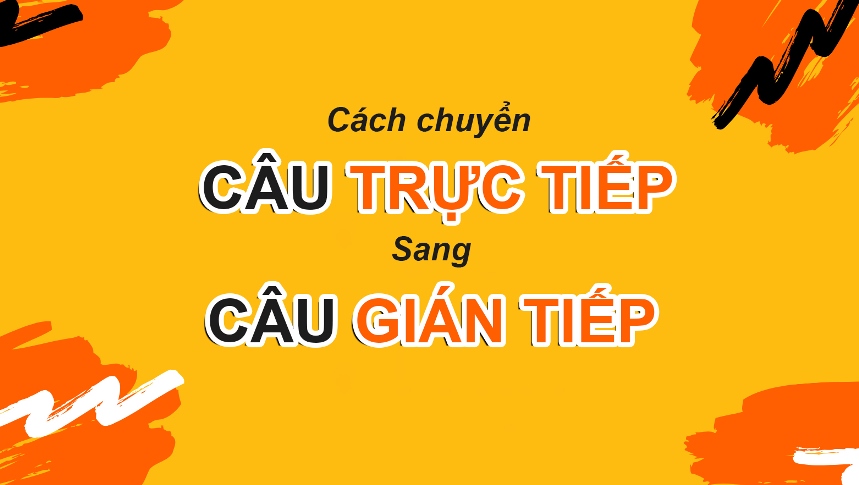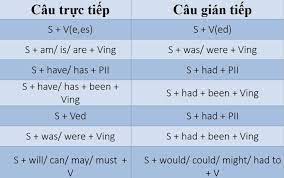Đúng, có khoảng 70% các đề bài thi tiếng Anh yêu cầu chuyển câu hỏi trực tiếp sang gián tiếp. Điều này đòi hỏi chúng ta phải hiểu rõ về hai dạng câu này. Hãy cùng tham gia bài học dưới đây của Aten English để nắm vững kiến thức này.
Sự khác biệt giữa câu trực tiếp – gián tiếp trong tiếng Anh
Câu trực tiếp
Câu trực tiếp là câu mà diễn đạt trực tiếp lời nói của người nói. Trong câu trực tiếp, chúng ta trích dẫn nguyên văn những từ và câu mà người nói thực sự nói ra.

Ví dụ
He said, “I am going to the store.”
She asked, “What time is the meeting?”
They shouted, “We won the game!”
Trong các câu trên, chúng ta trích dẫn chính xác những từ và câu mà người nói đã nói, sử dụng dấu ngoặc kép và dấu câu thích hợp.
Câu gián tiếp
Câu gián tiếp là cách diễn đạt lại nội dung của câu trực tiếp mà không sử dụng trực tiếp nguyên văn lời nói của người nói. Trong câu gián tiếp, chúng ta diễn đạt ý kiến, thông tin hoặc câu hỏi của người nói dưới dạng một câu chính và sử dụng các từ giới thiệu thông tin như “he said,” “she asked,” “they shouted,”…
Ví dụ:
He said that he was going to the store.
She asked what time the meeting was.
They shouted that they had won the game.
Trong các câu trên, chúng ta sử dụng các từ giới thiệu thông tin (he said, she asked, they shouted) để diễn đạt ý kiến, câu hỏi hoặc thông tin của người nói trong câu chính, và chuyển đổi các thì, các đại từ và các chi tiết khác để phù hợp với cấu trúc câu gián tiếp.
Cách chuyển câu hỏi trực tiếp sang gián tiếp trong tiếng Anh
Khi chuyển câu hỏi trực tiếp sang câu gián tiếp trong tiếng Anh, chúng ta thường sử dụng các từ giới thiệu thông tin như “asked,” “wondered,” “inquired,” “wanted to know,”… và thay đổi thứ tự từ và thì của câu.

Có một số quy tắc chung khi chuyển câu hỏi trực tiếp sang gián tiếp:
- Đổi thứ tự từ và thì của câu: Thông thường, thì của câu hỏi trực tiếp sẽ được chuyển sang quá khứ đơn trong câu gián tiếp. Các đại từ cũng thường phải thay đổi theo ngữ cảnh câu gián tiếp.
Ví dụ:
Trực tiếp: “Where is the library?” (Thư viện ở đâu?)
Gián tiếp: He asked where the library was. (Anh ấy hỏi thư viện ở đâu.)
- Loại bỏ dấu chấm hỏi: Trong câu gián tiếp, chúng ta không sử dụng dấu chấm hỏi như trong câu hỏi trực tiếp.
Ví dụ:
Trực tiếp: “What time does the movie start?” (Phim bắt đầu vào lúc mấy giờ?)
Gián tiếp: He asked what time the movie started. (Anh ấy hỏi phim bắt đầu vào lúc mấy giờ.)
- Sử dụng liên từ “if” hoặc “whether” khi chuyển câu hỏi yes/no:
Ví dụ:
Trực tiếp: “Will you come to the party?” (Bạn có đến buổi tiệc không?)
Gián tiếp: He asked if/whether I would come to the party. (Anh ấy hỏi tôi có đến buổi tiệc không.)
xem thêm: Chuyển đổi câu trực tiếp sang gián tiếp như thế nào cho đúng
Các bài tập câu tường thuật trong tiếng Anh

Bài 1: Hoàn thành các câu sau.
- “Where is my umbrella?” she asked.
She asked……………………………………… ………………….
- “How are you?” Martin asked us.
Martin asked us………………………………………… ……………….
- He asked, “Do I have to do it?”
He asked……………………………………… ………………….
- “Where have you been?” the mother asked her daughter.
The mother asked her daughter…………………………………… …………………..
- “Which dress do you like best?” she asked her boyfriend.
She asked her boyfriend………………………………….. ……………………..
- “What are they doing?” she asked.
She wanted to know………………………………………. …………………
- “Are you going to the cinema?” he asked me.
He wanted to know………………………………………. …………………
- The teacher asked, “Who speaks English?”
The teacher wanted to know………………………………………. ………………
- “How do you know that?” she asked me.
She asked me………………………………………… ……………….
- “Has Caron talked to Kevin?” my friend asked me.
My friend asked me………………………………………… ……………….
- “What’s the time?” he asked.
→ He wanted to know ………………………………………….. .
- “When will we meet again?” she asked me.
→ She asked me ………………………………………….. .
- “Are you crazy?” she asked him.
→ She asked him ………………………………………….. .
- “Where did they live?” he asked.
→ He wanted to know ………………………………………….. .
- “Will you be at the party?” he asked her.
→ He asked her ………………………………………….. .
- “Can you meet me at the station?” she asked me.
→ She asked me ………………………………………….. .
- “Who knows the answer?” the teacher asked.
→ The teacher wanted to know ………………………………………….. .
- “Why don’t you help me?” she asked him.
→ She wanted to know ………………………………………….. .
- “Did you see that car?” he asked me.
→ He asked me ………………………………………….. .
- “Have you tidied up your room?” the mother asked the twins.
→ The mother asked the twins …………………………………………..
- “Stop talking, Joe,” the teacher said.
→ The teacher told Joe ………………………………………….. .
- “Be patient,” she said to him.
→ She told him ………………………………………….. .
- “Go to your room,” her father said to her.
→ Her father told her ………………………………………….. .
- “Hurry up,” she said to us.
→ She told us ………………………………………….. .
- “Give me the key,” he told her.
→ He asked her ………………………………………….. .
- “Play it again, Sam,” she said.
→ She asked Sam ………………………………………….. .
- “Sit down, Caron” he said.
→ He asked Caron ………………………………………….. .
- “Fill in the form, Sir,” the receptionist said.
→ The receptionist asked the guest ………………………………………….. .
- “Take off your shoes,” she told us.
→ She told us ………………………………………….. .
- “Mind your own business,” she told him.
→ She told him ………………………………………….. .
- “Don’t touch it,” she said to him.
→ She told him ………………………………………….. .
- “Don’t do that again,” he said to me.
→ He told me ………………………………………….. .
- “Don’t talk to me like that,” he said.
→ He told her ………………………………………….. .
- “Don’t repair the computer yourself,” she warned him.
→ She warned him ………………………………………….. .
- “Don’t let him in,” she said.
→ She told me ………………………………………….. .
- “Don’t go out without me,” he begged her.
→ He begged her ………………………………………….. .
- “Don’t forget your bag,” she told me.
→ She told me ………………………………………….. .
- “Don’t eat in the lab,” the chemistry teacher said.
→ The chemistry teacher told his students ………………………………………….. .
- “Don’t give yourself up,” he advised her.
→ He advised her ………………………………………….. .
- “Don’t hurt yourselves, boys,” she said.
→ She told the boys ………………………………………….. .
ĐÁP ÁN
She asked me where her umbrella was.
Martin asked us how we were.
He asked if he had to do it.
The mother asked her daughter where she had been.
She asked her boyfriend which dress he liked best.
She wanted to know what they were doing.
He wanted to know if I was going to the cinema.
The teacher wanted to know who spoke English.
She asked me how I knew that.
My friend asked me if Caron had talked to Kevin.
He wanted to know what time it was.
She asked me when we would meet again.
She asked him if he was crazy.
He wanted to know where they had lived.
He asked her if she would be at the party.
She asked me if I could meet her at the station.
The teacher wanted to know who knew the answer.
She wanted to know why he didn’t help her.
He asked me if I had seen that car.
The mother asked the twins if they had tidied up their room.
The teacher told Joe to stop talking.
She told him to be patient.
Her father told her to go to her room.
She told us to hurry up.
He asked her to give him the key.
She asked Sam to play it again.
He asked Caron to sit down.
The receptionist asked the guest to fill in the form.
She told us to take off our shoes.
She told him to mind his own business.
She told him not to touch it.
He told me not to do that again.
He told her not to talk to him like that.
She warned him not to repair the computer himself.
She told me not to let him in.
He begged her not to go out without him.
She told me not to forget my bag.
The chemistry teacher told his students not to eat in the class.
He advised her not to give herself up.
She told the boys not to hurt themselves.
Trong bài học này, chúng ta đã tìm hiểu cách chuyển câu hỏi trực tiếp sang câu gián tiếp trong tiếng Anh. Việc này rất quan trọng vì khoảng 70% đề bài thi tiếng Anh yêu cầu chúng ta thực hiện điều này. Nếu bạn cảm thấy khó khăn trong việc học ngữ pháp tiếng Anh, hãy tham khảo khóa học tiếng anh online tại Aten ngay nhé.


